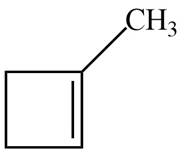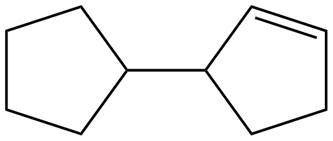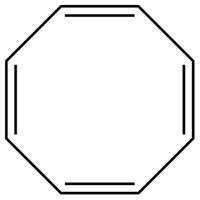
Concept explainers
(a)
Interpretation: The number of rings and number of pi bonds in A is to be determined. And one possible structure is to be drawn.
Concept introduction: Degree of unsaturation is used to determine the total number of rings and pi bonds present in compound by just looking at the molecular formula. It does not specify the total number of rings and total number of pi bonds individually.
Answer to Problem 12.35P
The number of pi bonds and number of rings in A is one. The possible structure is given in Figure 1.
Explanation of Solution
For compound A:
Before hydrogenation, the molecular formula is
The maximum number of
The maximum number of
The number of
Substitute the values of maximum number of
The degree of unsaturation is calculated by the formula,
Hence, the degree of unsaturation before hydrogenation is two.
After hydrogenation, the molecular formula is
The maximum number of
The maximum number of
The number
Substitute the values of maximum number of
The degree of unsaturation is calculated by the formula,
Hence, the degree of unsaturation after hydrogenation is one.
The number of pi bonds in A is calculated by the formula,
Substitute the values of degree of unsaturation before hydrogenation and degree of unsaturation after hydrogenation in the above formula.
Hence, the number of pi bonds is one.
Number of rings is calculated by the formula,
Substitute the values of degree of unsaturation and number of pi bonds in the above formula.
Hence, the number of rings is one.
The possible structure for A is,

Figure 1
The number of pi bonds and number of rings in A is one. The possible structure is given in Figure 1.
(b)
Interpretation: The number of rings and number of pi bonds in B is to be determined. And one possible structure is to be drawn.
Concept introduction: Degree of unsaturation is used to determine the total number of rings and pi bonds present in compound by just looking at the molecular formula. It does not specify the total number of rings and total number of pi bonds individually.
Answer to Problem 12.35P
The number of pi bonds and number of rings in B is one and two respectively. The possible structure is given in Figure 2.
Explanation of Solution
For compound B:
Before hydrogenation, the molecular formula is
The maximum number of
The maximum number of
The number of
Substitute the values of maximum number of
The degree of unsaturation is calculated by the formula,
Hence, the degree of unsaturation before hydrogenation is three.
After hydrogenation, the molecular formula is
The maximum number of
The maximum number of
The number
Substitute the values of maximum number of
The degree of unsaturation is calculated by the formula,
Hence, the degree of unsaturation after hydrogenation is two.
The number of pi bonds in A is calculated by the formula,
Substitute the values of degree of unsaturation before hydrogenation and degree of unsaturation after hydrogenation in the above formula.
Hence, the number of pi bonds is one.
Number of rings is calculated by the formula,
Substitute the values of degree of unsaturation and number of pi bonds in the above formula.
Hence, the number of rings is two.
The possible structure for B is,

Figure 2
The number of pi bonds and number of rings in B is one and two respectively. The possible structure is given in Figure 2.
(c)
Interpretation: The number of rings and number of pi bonds in B is to be determined. And one possible structure is to be drawn.
Concept introduction: Degree of unsaturation is used to determine the total number of rings and pi bonds present in compound by just looking at the molecular formula. It does not specify the total number of rings and total number of pi bonds individually.
Answer to Problem 12.35P
The number of pi bonds and number of rings in C is four and one respectively. The possible structure is given in Figure 3.
Explanation of Solution
For compound C:
Before hydrogenation, the molecular formula is
The maximum number of
The maximum number of
The number of
Substitute the values of maximum number of
The degree of unsaturation is calculated by the formula,
Hence, the degree of unsaturation before hydrogenation is five.
After hydrogenation, the molecular formula is
The maximum number of
The maximum number of
The number
Substitute the values of maximum number of
The degree of unsaturation is calculated by the formula,
Hence, the degree of unsaturation after hydrogenation is one.
The number of pi bonds in A is calculated by the formula,
Substitute the values of degree of unsaturation before hydrogenation and degree of unsaturation after hydrogenation in the above formula.
Hence, the number of pi bonds is four.
Number of rings is calculated by the formula,
Substitute the values of degree of unsaturation and number of pi bonds in the above formula.
Hence, the number of rings is one.
The possible structure for C is,

Figure 3
The number of pi bonds and number of rings in C is four and one respectively. The possible structure is given in Figure 3.
Want to see more full solutions like this?
Chapter 12 Solutions
Organic Chemistry
- 7. You discover a bottle of compound A with the label "C8H₁4" in the lab. Compound A decolourizes Br2 in CCl4 and becomes compound B (C8H14Br2). Treatment of B with two moles of potassium hydroxide produces compound C. Treatment of C with acidic potassium permanganate produces two four- carbon compounds: a diketone and a dialdehyde, respectively. However, treatment of A with acidic potassium permanganate produces only one product-compound D (shown below). Identify compounds A through C, clearly showing how you reached your conclusions. e Darrow_forwardClassify the carbocations as 1º, 2º, or 3º, and rank the carbocations in each group in order of increasing stability.arrow_forwardRank the following groups in order of decreasing priority. a. – COOH, – H, – NH2, – OH b. – H, – CH3, – Cl, – CH2CI c. -CH2CH3, -CH3, -H, -CH(CH3)2 d. – CH = CH2, – CH3, – C ≡ CH, – Harrow_forward
- The shrub ma huang (Section 5.4A) contains two biologically active stereoisomers—ephedrine and pseudoephedrine—with two stereogenic centers as shown in the given structure. Ephedrine is one component of a once-popular combination drug used by body builders to increase energy and alertness, whereas pseudoephedrine is a nasal decongestant. a.Draw the structure of naturally occurring (−)-ephedrine, which has the 1R,2S configuration. b.Draw the structure of naturally occurring (+)-pseudoephedrine, which has the 1S,2S configuration. c.How are ephedrine and pseudoephedrine related? d.Draw all other stereoisomers of (−)-ephedrine and (+)pseudoephedrine, and give the R,S designation for all stereogenic centers. e.How is each compound drawn in part (d) related to (−)-ephedrine?arrow_forward7.33 a-Farnesene is a constituent of the natural wax found on apples. What is its IUPAC name, including stereochemistry? 7.34 Menthene, a hydrocarbon found in mint plants, has the systematic name 1-isopropyl-4-methylcyclohexene. Draw its structure. 7.35 Draw and name the six alkene isomers, C5H1o, including E,Z isomers. a-Famesene 8.22 Name the following alkenes, and predict the products of their reaction with (1) meta-chloroperoxybenzoic acid, (2) KMnO4 in aqueous acid, and (3) 03, followed by Zn in acetic acid: (a) (b) (a) 8.23 Draw the structures of alkenes that would yield the following alcohols on hydration (red = O). Tell in each case whether you would use hydroboration- oxidation or oxymercuration-demercuration. (b)arrow_forwardAn ion with a positively charged nitrogen atom in a three-membered ring is called an aziridinium ion. The following aziridinium ion reacts with sodiummethoxide to form compounds A and B: If a small amount of aqueous Br2 is added to A, the reddish color of Br2 persists, but the color disappears when Br2 is added to B. When the aziridinium ion reacts with methanol, only A is formed. Identify A and B.arrow_forward
- 10. Consider the hydrogenation reaction of compound X to Y: H₂, Pt X (C8H14) →Y (C8H16) 25°C One can conclude that X has: A) no rings and no double bonds. B) no rings and one double bond. C) one ring and one double bond. D) two rings and no double bonds. E) one triple bond.arrow_forwardFour isomers A-D with the formula C5H12O exhibit different reactivity patterns as indicated below. Isomer A reacts with PCC and CrO3 to provide identical products. Isomer B reacts with PCC and CrO3 to provide different products. Isomers C and D do not react with either PCC or CrO3. Isomers A, B, and C readily react with NaH but D does not show any reactivity with NaH. The 1H NMR splitting patterns for these isomers are as follows. Isomer A: δ 0.91 (d, 3H), 0.90 (d, 3H), 1.18 (d, 3H), 1.92 (dqq, 1H), 3.38 (dq, 1H), 3.58 (bs, 1H). Isomer B: δ 1.25 (s, 9H), 3.45 (s, 2H), 3.65 (bs, 1H). Isomer C: δ 0.90 (t, 3H), 1.44 (q, 2H), 1.24 (s, 6H), 3.65 (bs, 1H). Isomer D: δ 1.10 (t, 3H), 1.13 (d, 6H), 3.19 (septet, 1H), 3.50 (q, 2H). Based on all of this information, provide the structures of A-D. (Note: If there is a chiral center on any of these molecules, assume the stereochemistry as “R”. dqq=doublet of a quartet of a quartet, bs=broad singlet)arrow_forwardCompound W O₂, H₂O₂ A Compound W could likely be: H3 CH₂ CH3 O B MgBr {₁ C MgBr Compound X Darrow_forward
- Label each pair of alkenes as constitutional isomers or stereoisomers. Select the single best answer for each part below. Part 1 of 3 H₂C=CHCH₂CH₂CH₂CH₂CH₂CH3 and H₂CH₂CHC=CHCH₂CH₂CH₂CH₂ O stereoisomers O constitutional isomers Part 2 of 3 H₂C H Part 3 of 3 O constitutional isomers O stereoisomers H₂C H CH₂CH3 H₂C H X CH₂CH₂CH₂CH₂ H O constitutional isomers O stereoisomers X CH₂ H X H₂C 5 CH₂CH₂CH₂CH₂ H 00 ← B 00 Ar !arrow_forwardUnder certain reaction conditions, 2,3-dibromobutane reacts with twoequivalents of base to give three products, each of which contains twonew π bonds. Product A has two sp hybridized carbon atoms, product Bhas one sp hybridized carbon atom, and product C has none. What arethe structures of A, B, and C?arrow_forward4. Two compounds A and B isolated from plants have the following chemical data. Determine the their structures from the data provided (and give the structures of their derivative C) A H2 C 1. Оз C15H28 А, С15Н24 C15H24 Pd/C H 2. NaHSO3 В H2 C H. C15H24 Pd/C C15H28 A HBr Br 1. Оз В, С15Н24 C15H24 2. NaHSO3 В Br HBr C15H24arrow_forward
